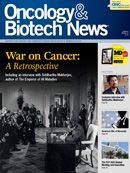ASH 2010: Carfilzomib Shrinks Tumors in More Than One-Third of Pretreated Myeloma Patients
Carfilzomib, described as a next-generation protease inhibitor, produced durable responses in patients with multiple myeloma whose disease relapsed after or proved refractory to all available therapies.
Carfilzomib, described as a next-generation protease inhibitor, produced durable responses in patients with multiple myeloma whose disease relapsed after or proved refractory to all available therapies, including bortezomib (Velcade) and immunomodulatory agents. Based on results from this phase IIb trial, Onyx Pharmaceuticals announced plans to file a New Drug Application with the FDA in mid-2011. “Carfilzomib has the potential to offer substantial clinical benefit to patients with relapsed or refractory disease,” said lead author David Siegel, MD, PhD, division chief for myeloma from John Theurer Cancer Center in Hackensack, New Jersey.
The findings are important because although several effective therapies exist for multiple myeloma, nearly 100% of patients eventually relapse or become refractory to treatment. Patients who relapse on a given drug often will not respond to reintroduction of that drug, and Siegel said more effective therapies are needed to help patients attain durable remissions. In addition, new treatment options are critical for patients who have exhausted current ones. In an interview with Oncology & Biotech News, Siegel said multiple myeloma is a challenge to treat because “the disease mutates very quickly.”
The open-label, single-arm, phase IIb trial enrolled 266 patients (median age, 66 y) in the United States with multiple myeloma whose disease had relapsed after or was refractory to at least 2 prior therapies. At least one of these therapy lines had to have been bortezomib (Velcade) and thalidomide or lenalidomide (Revlimid) plus an alkylating agent. For purposes of the study, investigators defined refractory disease as a decrease in serum paraprotein levels that was ≤25% or progression within 60 days of completing the last chemotherapy regimen.
A median of 5.5 years had elapsed since patients’ initial diagnosis. Patients had received a median of 5 prior lines of therapy, and ~75% had undergone autologous stem cell transplant before enrollment. The study’s primary endpoint was overall response rate (ORR), and secondary endpoints included clinical benefit rate (CBR), duration of response, overall survival (OS), time to progression, progression-free survival, and safety.
Patients received 20 mg/m2 of carfilzomib for the first cycle, followed by ≥12 cycles using a 27-mg/m2 dose; only those patients who completed 12 cycles were allowed to participate in the study extension. Of the 266 patients, 257 were evaluable for response (Table). The ORR, representing patients who achieved partial response (defined as a 50% decrease in serum paraprotein levels) or better was 24.1% in these multiply relapsed patients with progressive disease at study entry, and median duration of response was 8.3 months. The CBR (complete or partial remission or stable disease) was 34.2%. Median OS was 15 months, much better than the 9 months investigators had expected at the outset of the study, said Siegel. The OS for patients who demonstrated minimal response or better has not yet been reached, but the investigators estimate that it will ultimately exceed 19 months.
The most common grade 3/4 adverse events were thrombocytopenia (27%), anemia (22%), lymphopenia (18%), and neutropenia (10%). At study entry, more than three-quarters (77%) of patients had grade 1/2 peripheral neuropathy. During the study, new or worsening peripheral neuropathy was uncommon, occurring in <1% of patients. “There was only 1 patient in the entire 266 that seemed to get bad peripheral neuropathy, and it only lasted a short time, after which the patient was able to continue therapy,” said Siegel. Carfilzomib is associated with a lower rate of peripheral neuropathy than currently approved agents, he added, which results in a lower likelihood of treatment discontinuation. None of the patients in the study developed grade 4 peripheral neuropathy while being treated with carfilzomib.
In a subset analysis of patients with peripheral neuropathy, efficacy appeared comparable to that seen in the overall study population, with an ORR of 24% and a CBR of 34%. Another subset analysis looked at data for 128 patients who received a bortezomib (Velcade)-based regimen as their last line of therapy prior to the study. These patients had an ORR of 19% and a clinical benefit rate of 31%. Stratifying patients according to the number of bortezomib-based regimens received found that 30% of the 122 patients treated with only 1 prior bortezomib regimen responded to carfilzomib, and the CBR rate in this group was 40%.
Siegel told Oncology & Biotech News that the research team is continuing to review the data for carfilzomib in multiple myeloma from this and other trials in an effort to find any molecular or biological markers that might correlate with response. No markers have been identified thus far, he said.
The “bottom line” said Siegel, is that carfilzomib is a “great drug” based on data collected to date. “This heavily pretreated patient population has received all classes of approved and commonly used myeloma therapies, and the durable responses and tolerability demonstrate carfilzomib’s potential as a promising treatment.”
_________________________________________________________________________
Siegel DS, Martin T, Wang, M, et al. Results of PX-171- 003-A1, an open-label, single-arm, phase 2 study of carfilzomib in patients with relapsed and refractory multiple myeloma. Presented at: 52nd ASH Annual Meeting and Exposition; December 4-7, 2010; Orlando, Florida.




